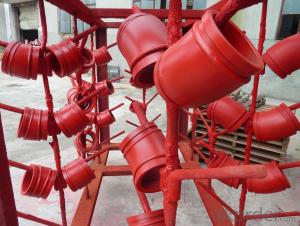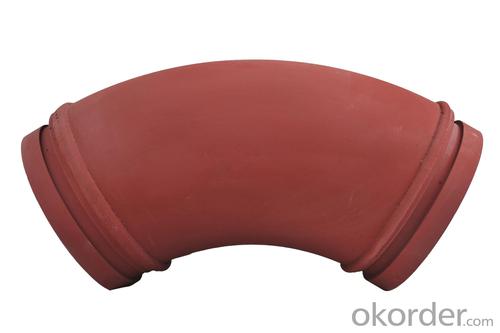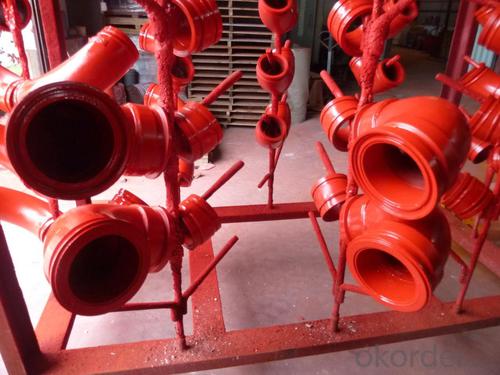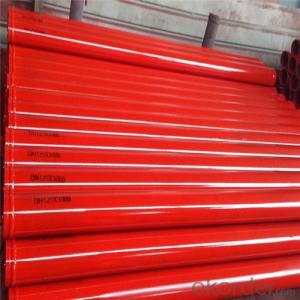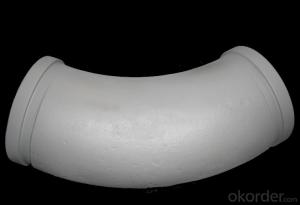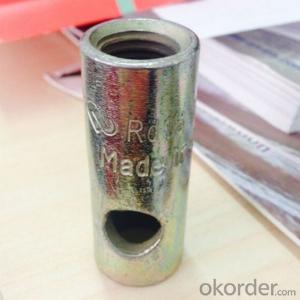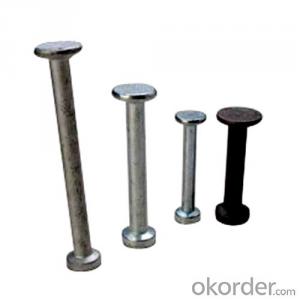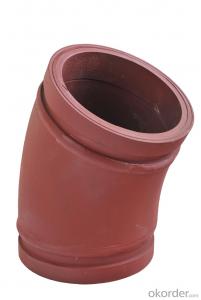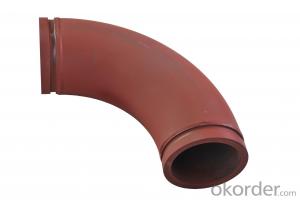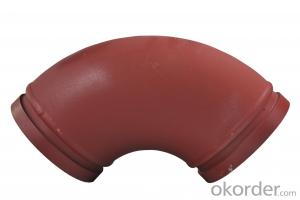Twin Wall Elbow for Concrete Pump R232 60DGR
- Loading Port:
- Tianjin
- Payment Terms:
- TT OR LC
- Min Order Qty:
- 10 pc
- Supply Capability:
- 3000 pc/month
OKorder Service Pledge
OKorder Financial Service
You Might Also Like
Twin Wall Elbow (Twin Wall Flange)
(1) Material: Q235 (outside) + GCr15(inside)
(2) Thickness: 3mm (outside) + 9mm (inside)
(3) Technology: Quenching under high temperature
(4) Characteristics: the inner rigidity to 63 HRC; the outside has so high toughness to keep the inner.
(5) Matched with: Twin wall flange, Alloy (GCr15) + 20#
(6) Working Pressure:170bar
(7) Service life: above 60,000 cubic meters.
(8) Package: PP woven bag and plastic cap
Twin wall elbow is created with research of us and need of the market. Its service life and working pressure are better than the casting. Besides, We can supply 90D, 45D, 30D, 25D, 20D, 15D, 10D. And it can be used for PM, JUNJIN, Schwing, Cifa, Sany, ect.
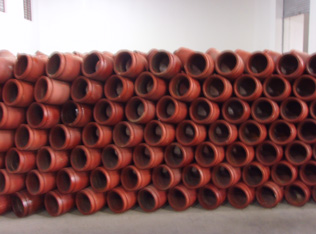
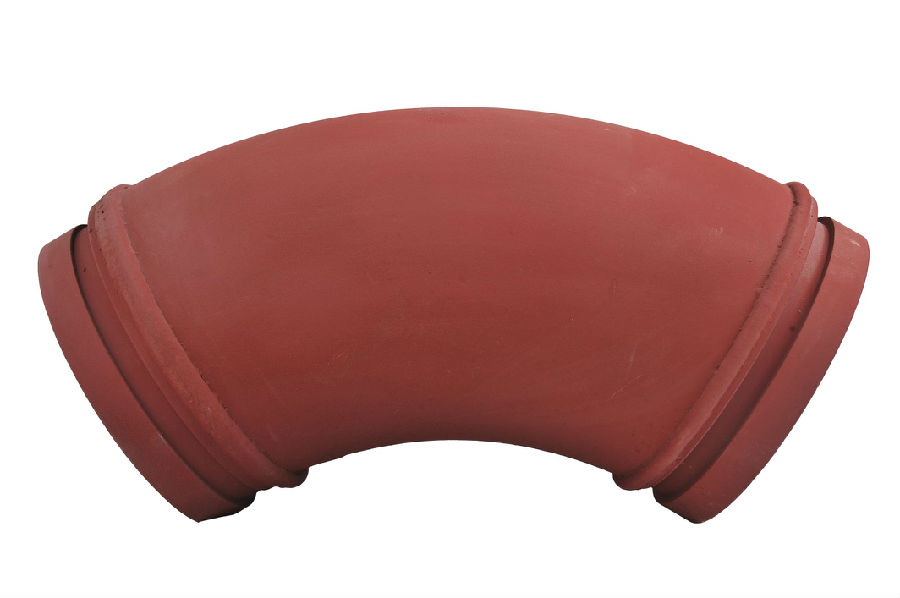
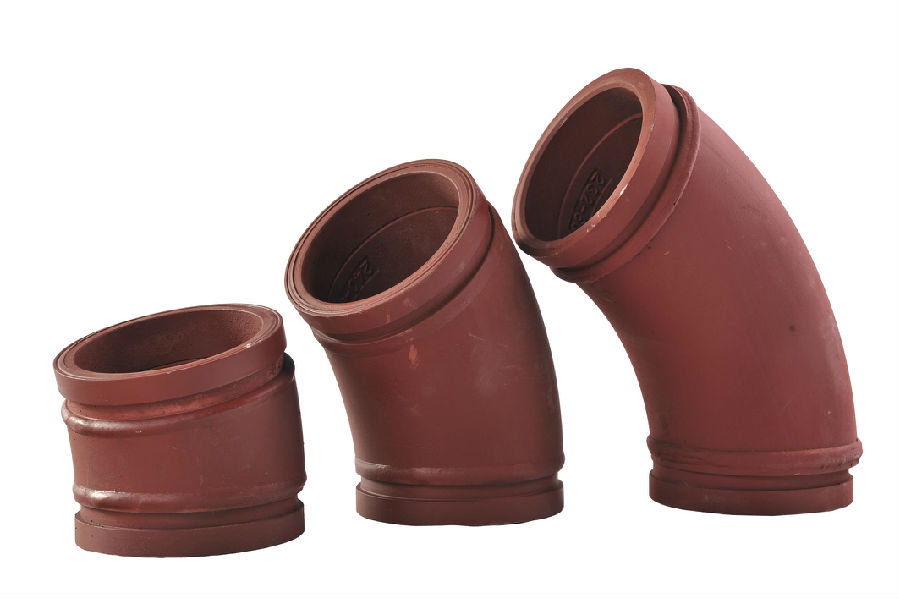
- Q: Can I get spare parts for concrete pump hydraulic cylinders and valves?
- Yes, you can definitely get spare parts for concrete pump hydraulic cylinders and valves. There are numerous companies and suppliers that specialize in providing spare parts for construction equipment, including hydraulic cylinders and valves for concrete pumps. These spare parts can be easily sourced online or through local distributors. It is important to ensure that you provide accurate information about the make and model of your concrete pump to ensure compatibility and proper functioning of the spare parts. Additionally, it is advisable to choose reputable suppliers who offer high-quality, genuine spare parts to guarantee optimal performance and durability.
- Q: What is the role of a concrete pump agitator shaft seal?
- The purpose of a seal on the agitator shaft of a concrete pump is to prevent any substances, like concrete or grout, from leaking or seeping out. Its design aims to create a secure seal between the rotating shaft and the fixed housing, guaranteeing that no materials escape while the pump is in use. This is crucial for upholding the pump's efficiency and effectiveness by preventing any loss of material. Additionally, the seal safeguards the agitator shaft from potential harm caused by external contaminants such as dirt or water, which could potentially damage the pump. Overall, the concrete pump agitator shaft seal is essential for ensuring the pump operates smoothly and reliably while maintaining the quality of the materials being pumped.
- Q: Are there any specific cleaning and maintenance procedures for concrete pump spare parts?
- Yes, there are specific cleaning and maintenance procedures for concrete pump spare parts. Regular cleaning of the spare parts is necessary to remove any dirt, debris, or concrete buildup that may affect their performance. This can be done using water, mild detergent, and a brush to scrub the parts gently. Additionally, lubrication of moving parts and regular inspection for wear and tear is crucial to ensure optimal functioning and longevity of the spare parts.
- Q: Are there any specific tools or equipment required for the installation of concrete pump spare parts?
- Yes, there are specific tools and equipment required for the installation of concrete pump spare parts. Some of these tools include: 1. Wrenches and sockets: These are used to loosen and tighten bolts and nuts during the installation process. 2. Hydraulic jacks: Hydraulic jacks are necessary for lifting heavy parts of the concrete pump to provide easy access for installation. 3. Crane or hoist: In cases where the parts are extremely heavy, a crane or hoist may be required to lift and position them correctly. 4. Torque wrench: This tool is essential for tightening bolts to the correct torque specifications, ensuring a secure installation. 5. Grease gun: Lubrication is important for smooth operation of moving parts, so a grease gun is used to apply grease to specific components during installation. 6. Measuring tools: Measuring tapes or rulers are necessary to ensure accurate positioning and alignment of the spare parts. 7. Safety equipment: Safety goggles, gloves, and other protective gear should be worn during the installation process to prevent injuries. It is important to note that the specific tools and equipment required may vary depending on the type and complexity of the concrete pump and its spare parts. It is always recommended to consult the manufacturer's instructions or seek professional assistance to ensure proper installation.
- Q: How often should concrete pump remote controls be inspected and maintained?
- Concrete pump remote controls should be inspected and maintained regularly, ideally on a monthly basis, to ensure proper functioning and safety.
- Q: How often should carbide wear plates be replaced in a concrete pump?
- The replacement frequency of carbide wear plates in a concrete pump is dependent on various factors. These include the type and quality of the plates, the intensity of usage, and the specific operating conditions of the pump. Carbide wear plates are designed to withstand the abrasive nature of concrete and generally have a longer lifespan compared to traditional steel plates. However, they are not immune to deterioration and will eventually wear down over time. A good practice is to regularly inspect the wear plates and assess their condition. If there are visible cracks, excessive erosion, or a decrease in concrete flow performance, it is time to consider replacing them. Replacement intervals can vary, ranging from annual replacements to several years. To extend the lifespan of carbide wear plates, proper maintenance and care are crucial. This includes regular cleaning, ensuring proper lubrication, and avoiding excessive pressure or abuse during operation. By conducting regular maintenance, the wear plates can last longer and replacements can be less frequent. It is advisable to consult the manufacturer's guidelines or seek advice from a professional concrete pump technician to determine the specific replacement interval for carbide wear plates in a particular pump model. Their expertise and knowledge will provide accurate recommendations based on the specific conditions and usage of the concrete pump.
- Q: What is the function of a concrete pump hydraulic accumulator?
- The function of a concrete pump hydraulic accumulator is to store energy from the hydraulic system and release it when needed, providing a surge of power to the concrete pump. This helps to maintain a consistent and smooth flow of concrete, preventing any disruptions or blockages in the pumping process.
- Q: Can concrete pump spare parts be tested for compatibility with different types of concrete mixes?
- Testing for compatibility with different types of concrete mixes is crucial for concrete pump spare parts. These spare parts, including pipes, hoses, and valves, are specifically designed to handle distinct pressures, flow rates, and concrete mix types. To determine compatibility, the spare parts undergo testing with various concrete mix compositions, which encompass diverse aggregate sizes, cement types, and admixtures. This testing procedure assesses the spare parts' ability to withstand the unique characteristics and properties of different concrete mixes. The compatibility testing process evaluates factors such as durability, resistance to abrasion and corrosion, and the capacity to meet specific pumping requirements for various concrete mixes. This testing can be carried out either in laboratory settings or on-site, depending on the project's specific needs. By conducting compatibility testing on concrete pump spare parts, potential issues like clogging, wear and tear, or reduced performance can be identified and resolved in advance. This ensures smoother and more efficient concrete pumping operations, reducing downtime and enhancing overall productivity. It is important to note that manufacturers of concrete pump spare parts often provide technical specifications and guidelines for their products, including information on compatibility with different concrete mix types. Adhering to these guidelines and performing compatibility testing aids in achieving optimal performance and longevity of the spare parts, resulting in successful concrete pumping operations.
- Q: Can concrete pump spare parts be imported from other countries?
- Yes, concrete pump spare parts can be imported from other countries.
- Q: What are the common signs of wear and tear in a concrete pump cylinder?
- Some common indications that a concrete pump cylinder is experiencing wear and tear include: 1. Leakage of oil or hydraulic fluid: The presence of oil or hydraulic fluid leaking from the cylinder is a clear indication that it has sustained damage or wear. This could be a result of cracks, worn seals, or damaged gaskets. 2. Decreased pumping efficiency: A worn cylinder may lead to a reduction in pumping efficiency, resulting in the concrete pump's inability to deliver the same amount of concrete as before. This decline could be due to a decrease in the cylinder's internal diameter or worn piston rings. 3. Heightened noise and vibration: As the cylinder deteriorates, it may produce more noise and vibration during operation. This can suggest issues like misalignment, loose components, or damaged internal parts. 4. Uneven or rough concrete output: A worn cylinder can cause the concrete output to be uneven or rough. This issue may arise from an irregular internal surface or damaged piston rings, which disrupt the smooth movement of the piston. 5. Excessive generation of heat: A worn concrete pump cylinder may generate additional heat while in operation. This can be attributed to increased friction between moving parts, which can further contribute to accelerated wear and tear. 6. Visible damage or corrosion: By inspecting the cylinder's surface, visible signs of wear and tear such as scratches, dents, or corrosion can be identified. These damages can compromise the cylinder's integrity and may necessitate repair or replacement. It is crucial to regularly inspect the concrete pump cylinder and promptly address any signs of wear and tear to prevent further damage and maintain the pump's optimal performance.
Send your message to us
Twin Wall Elbow for Concrete Pump R232 60DGR
- Loading Port:
- Tianjin
- Payment Terms:
- TT OR LC
- Min Order Qty:
- 10 pc
- Supply Capability:
- 3000 pc/month
OKorder Service Pledge
OKorder Financial Service
Similar products
Hot products
Hot Searches
Related keywords



